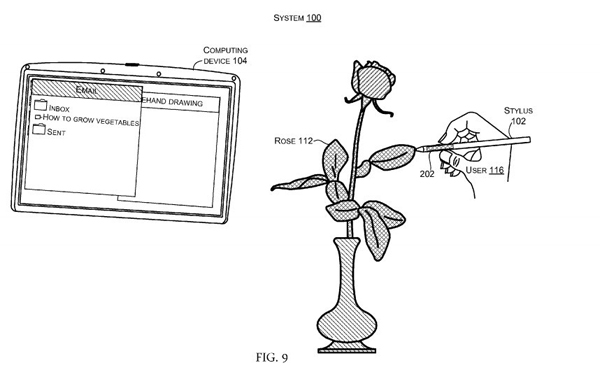Microsoft has placed particular emphasis on the style of Surface devices, given that this is an accessory that, objectively, gives an edge to tablets and 2-in-1 Surface Book. Not surprising that the Redmond continues to carry on the path of refinement of this accessory patenting technologies that, in the future, could further enrich its capabilities. Yesterday the US USPTO has granted a new patent to Redmond (US Pub. No. 2016/0048221 A1) that relates to a new type of stylus can recognize colors and textures of real objects, turning them into digital representations .
The usage scenarios are manifold, starting from the most simple ones that provide the possibility of use in a graphics program the colors captured in the real world. Among the various use cases illustrated by Microsoft one concerns the possibility of associating the initiation of specific applications to the recognition of certain colors, but the same technique could be used to start the individual functions of an application, for example, the selection of a group of mails associated with a color. Easy to see that, after having metabolized the principle of operation, the execution of the tasks may be accelerated by using the special stylus and pad to a stylus or a mouse pad equipped with an articulated palette colors.
Even more complex and rich in practical implications is a second mode of use of the stylus, able not only to recognize the colors, but also the external appearance of the object, or the surface texture, operating in combination with a dense network of sensors, including accelerometers, gyroscopes and microphones. Swiping the stylus on the object, it would be possible to thereby determine and digitize the texture of the material acquiring resources for design studios or suitable for use in the field of 3D modeling.
The assignment of the patent does not translate in the confirmation of the development of a commercial product based on new technology. Microsoft has filed a patent application in 2014, but, in parallel, no product developed and marketed by Redmond has been equipped with a special system for color scanning and texture. Microsoft is always at the forefront of testing new and better forms of interaction "man-machine" and it is not impossible that, in the future, the principle summarized in the new patent will be made into consumer products.
The usage scenarios are manifold, starting from the most simple ones that provide the possibility of use in a graphics program the colors captured in the real world. Among the various use cases illustrated by Microsoft one concerns the possibility of associating the initiation of specific applications to the recognition of certain colors, but the same technique could be used to start the individual functions of an application, for example, the selection of a group of mails associated with a color. Easy to see that, after having metabolized the principle of operation, the execution of the tasks may be accelerated by using the special stylus and pad to a stylus or a mouse pad equipped with an articulated palette colors.
The assignment of the patent does not translate in the confirmation of the development of a commercial product based on new technology. Microsoft has filed a patent application in 2014, but, in parallel, no product developed and marketed by Redmond has been equipped with a special system for color scanning and texture. Microsoft is always at the forefront of testing new and better forms of interaction "man-machine" and it is not impossible that, in the future, the principle summarized in the new patent will be made into consumer products.

Comments
Post a Comment